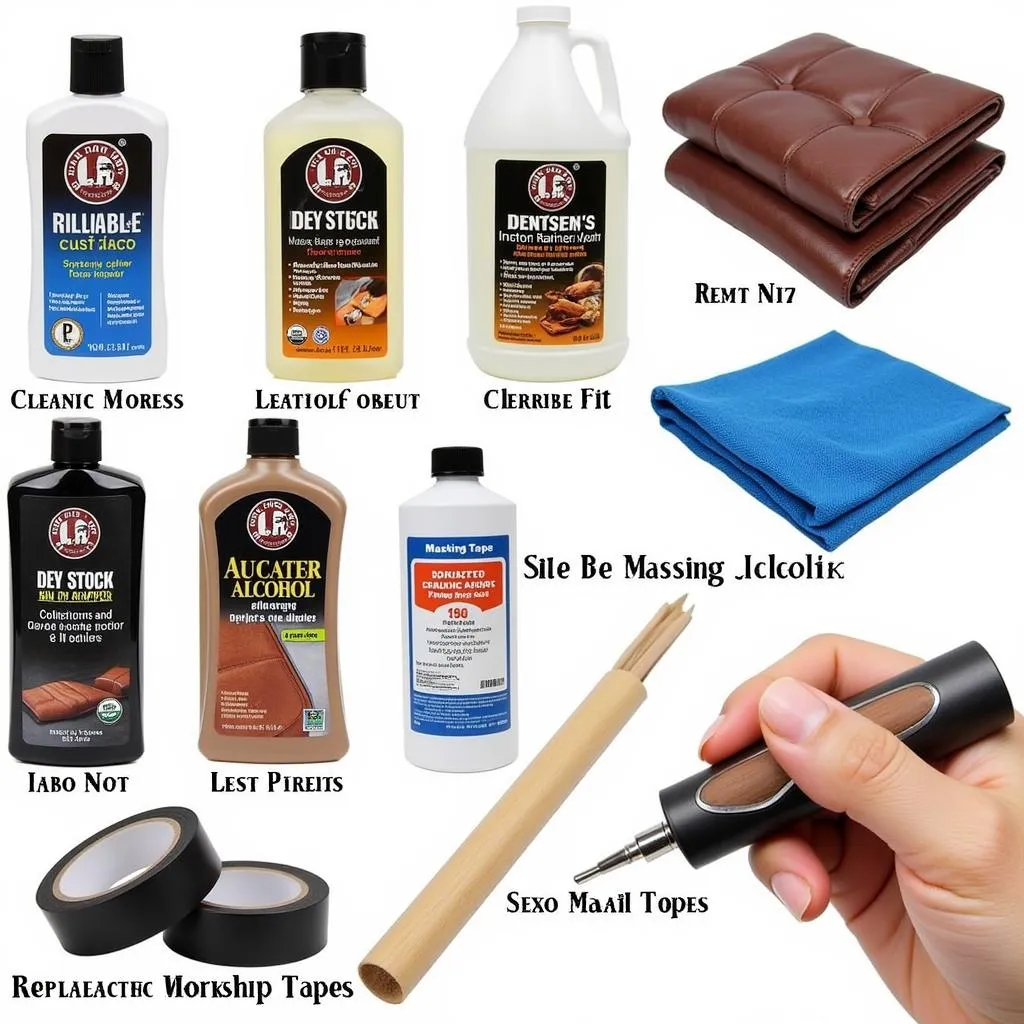Leather car seats exude a luxurious feel, but they require special care to maintain their pristine condition. Over time, wear and tear can lead to cracks, scratches, and fading. Fortunately, you can restore your leather car seats to their former glory with the right approach. This guide will provide you with a step-by-step process on how to repair leather seats in a car, ensuring a professional-looking outcome.
Understanding the Damage
Before diving into the repair process, it’s crucial to assess the extent of the damage. Leather car seat damage can range from minor scratches and scuffs to deep cracks and tears.
- Surface Scratches and Scuffs: These are often easily remedied with gentle cleaning and conditioning.
- Cracks and Tears: These require a more involved approach, including filling, patching, and color matching.
- Fading and Discoloration: Prolonged exposure to sunlight can cause the leather to fade. Restoring the color typically involves using leather dyes or pigments.
Gathering the Necessary Materials
Having the right tools and materials on hand will make the leather seat repair process much smoother. Here’s a list of essentials:
- Leather Cleaning Agent: Opt for a pH-neutral cleaner specifically designed for automotive leather.
- Leather Conditioner: This helps to moisturize the leather and prevent future cracks.
- Leather Repair Kit: Choose a kit that matches the color of your car seats as closely as possible. These kits typically contain filler paste, a colorant, and various applicators.
- Soft Cloths: Microfiber cloths are ideal as they are lint-free and won’t scratch the leather.
- Rubbing Alcohol: This is useful for cleaning the affected areas before applying any repairs.
- Masking Tape: Use this to protect surrounding areas when working with dyes or fillers.
- Hair Dryer (Optional): Can be used to speed up the drying process of leather fillers and dyes.
Step-by-Step Leather Car Seat Repair Guide
Follow these steps meticulously to achieve the best possible results:
-
Clean the Affected Area: Start by thoroughly cleaning the damaged area with a leather cleaning agent and a soft cloth. This removes dirt, grime, and any other residues that could interfere with the repair process.
-
Allow to Dry Completely: Before proceeding, ensure that the cleaned area is completely dry. You can use a hairdryer on a low heat setting to speed up the drying process if needed.
-
Apply Leather Filler (If Necessary): For cracks and tears, apply a leather filler to the damaged area using a putty knife or similar tool. Carefully follow the instructions provided with the leather repair kit.
-
Sand the Filler Smooth: Once the filler has dried, gently sand the area using fine-grit sandpaper until it’s smooth and flush with the surrounding leather.
-
Clean Again After Sanding: After sanding, wipe away any dust or residue with a clean, damp cloth.
-
Apply Leather Dye or Colorant: Using a sponge applicator or a cotton swab, carefully apply the leather dye or colorant from your repair kit to the repaired area. Apply thin, even coats, allowing each coat to dry completely before applying the next.
-
Blend the Color (If Necessary): To ensure a seamless blend with the surrounding leather, you can use a clean cloth to gently feather the edges of the dye outward.
-
Apply Leather Conditioner: Once the dye is completely dry, apply a high-quality leather conditioner to the entire seat. This helps to restore moisture, protect the leather, and prevent future damage.
Tips for Professional Results
- Test the Repair Kit: Before applying any product to your car seats, test it on a hidden area first to ensure color compatibility and to avoid any unexpected reactions.
- Work in a Well-Ventilated Area: Leather dyes and fillers often have strong odors, so it’s best to work in a well-ventilated area or outdoors.
- Be Patient: Allow ample drying time between each step of the repair process. Rushing can lead to subpar results.
- Consider Professional Help: For extensive damage or if you’re unsure about DIY repairs, it’s advisable to seek professional leather repair services.
Frequently Asked Questions
Q: Can I use any type of leather cleaner on my car seats?
A: It’s crucial to use a pH-neutral cleaner specifically designed for automotive leather to avoid damaging the material.
Q: How often should I condition my leather car seats?
A: It’s generally recommended to condition your leather car seats every three months or as needed, depending on factors like climate and usage.
Q: Can I repair a tear in my leather car seat myself?
A: While minor tears can be repaired using a leather repair kit, larger tears may require professional attention for optimal results.
Q: How can I prevent my leather car seats from cracking?
A: Regular cleaning, conditioning, and minimizing exposure to direct sunlight will help prevent premature cracking of your leather car seats.
Q: What should I do if I spill something on my leather car seats?
A: It’s essential to address spills immediately. Blot the spill with a clean cloth, and then use a leather cleaner to remove any residue.
Conclusion
Repairing leather car seats is an achievable task that can save you money and restore the beauty of your car’s interior. By following the steps outlined in this guide and using the right tools and materials, you can achieve professional-looking results. Remember that patience and attention to detail are key. However, for extensive damage or if you’re unsure about DIY repairs, it’s always best to consult a professional.
For more in-depth guides on car repairs, check out our articles on how to repair a leather car seat with heated seats, best way to repair leather car seats and how to repair wear on leather car seats.
If you need help with choosing the right black leather repair kit for car seats or want to know how much does it cost to repair leather car seats, we’ve got you covered!
For immediate assistance, feel free to reach out to us via WhatsApp: +1(641)206-8880 or Email: [email protected]. Our dedicated customer support team is available 24/7 to address your queries and provide expert guidance.



